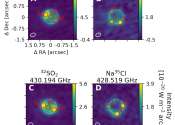A volcano is an opening, or rupture, in a planet's surface or crust, which allows hot, molten rock, ash, and gases to escape from below the surface. Volcanic activity involving the extrusion of rock tends to form mountains or features like mountains over a period of time. The word volcano is derived from the name of Vulcano island off Sicily. In turn, it was named after Vulcan, the Roman god of fire.
Volcanoes are generally found where tectonic plates are diverging or converging. A mid-oceanic ridge, for example the Mid-Atlantic Ridge, has examples of volcanoes caused by divergent tectonic plates pulling apart; the Pacific Ring of Fire has examples of volcanoes caused by convergent tectonic plates coming together. By contrast, volcanoes are usually not created where two tectonic plates slide past one another. Volcanoes can also form where there is stretching and thinning of the Earth's crust (called "non-hotspot intraplate volcanism"), such as in the African Rift Valley, the Wells Gray-Clearwater volcanic field and the Rio Grande Rift in North America and the European Rhine Graben with its Eifel volcanoes.
Volcanoes can be caused by mantle plumes. These so-called hotspots, for example at Hawaii, can occur far from plate boundaries. Hotspot volcanoes are also found elsewhere in the solar system, especially on rocky planets and moons.









